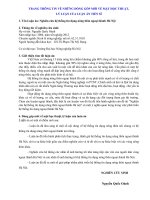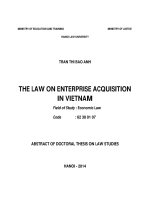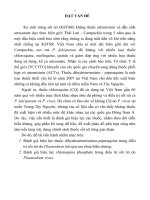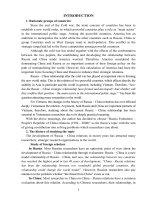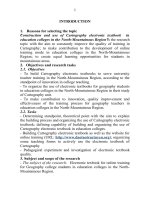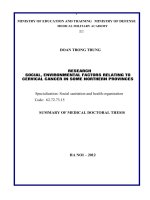5 thong tin luan an tieng anh
Bạn đang xem bản rút gọn của tài liệu. Xem và tải ngay bản đầy đủ của tài liệu tại đây (114.01 KB, 6 trang )
MINISTRY OF EDUCATION AND TRAINING
DUY TAN UNIVERSITY
RESEARCH SOME TECHNIQUES PROCESSING OBJECT
AND APPLICATION SIMULATION IN MEDICAL
Majors
: Computer science
Code
: 9480101
THESIS INFORMATION PAGE
DA NANG – 2022
DOCTORAL THESIS INFORMATION PAGE
Thesis topic: RESEARCH SOME TECHNIQUES PROCESSING
OBJECT AND APPLICATION SIMULATION IN MEDICAL
Majors: Computer science
Code: 9480101
PhD student: Le Van Chung
Gender: Male
Date of birth: Dec/12/1982
Place of birth: Da Nang
Science instructor:
1. Assoc. Dr. Le Dac Nhuong
2. Dr. Jolanda G. Tromp
Training facilities: Duy Tan University
1. The main contribution of the thesis is as follow:
Each chapter of the thesis contains research findings that are supported and
verified by studies that have been published at eminent national and international
conferences and journals. The contributions that stand out most are:
(1) Propose an effective RGB color selection technique for complex 3D
object structures based on a combination of tagging and marking methods by
selecting an RGB color area on the object structure. From the RGB color, codes
proceed with ID tagging and the creation of relational tables that store relevant
information about specific areas of the anatomy. Using the entire set of color
values $(R, G, B)$ to define a set of anatomical regions helps to define multiple
overlapping areas of an object for efficient representation of complex objects, and
more clearly.
(2) Technical proposal to improve the efficiency of multi-user interaction
in augmented reality with scenarios where users have the same geospatial and
different geospatial. The solution is to identify and mark the pins and interactive
positions on 3D objects to set the color area and interactive position under
different views of multiple users on the same object. The proposed technique
allows multiple interactions to be performed simultaneously on many different
devices with multiple users at the same time with low latency and accurate
visualization of the virtual reality model location..
(3) Propose a Memetic algorithm to enhance encryption of medical data in
transit in IoT-based distributed systems using a Memetic algorithm combined
with DWT transformation. The results of the proposed algorithm are evaluated
using performance metrics such as PSNR, MSE, SSIM, correlation, SC, and BER
which show the efficiency of the proposed algorithm compared to existing
methods. When comparing the histogram of the covered messages and the original
message both in color and grayscale images, there is not much deviation in the
PSNR values, which indicates that the proposed algorithm works well. in the
encoding and decoding process. Therefore, security concerns in the healthcare
system through IoT are highly secure and safe.
(4) Applying the above techniques to build a simulation system of the
human body. The system provides an interface that allows the user to manipulate
to observe the images of the parts that can be searched and looked up information
through the sample information.
2. Possibility of reality application
In the context of the "content-oriented" education and training becoming
inadequate and having many shortcomings, schools are clearly seeing the
importance of a training model that goes hand in hand with practice to help
students develop comprehensive capacity after graduation. In order to serve
teaching, learning, and research well, schools need to carry out training associated
with practice through practice models. This is extremely important for medical
students related to anatomy because there are no human corpses to practice with.
The goal of the simulation system is built toward the application of virtual
reality 3D technology to simulate the Vietnamese human body intuitively, and
accurately with a 1:1 ratio with a full range of organ systems allowing the ability
to interact directly in 3D space. Support system, serving teaching, learning, and
research in the field of health sciences to reach career goals, able to work in a
dynamic and fast-changing new world.
3. Further research directions:
The concerns raised in the thesis span a wide range of topics, making it
feasible to identify issues that might be utilized to suggest topics as a study
direction for the next projects for each topic given in each chapter. That
demonstrates the concerns raised by the Ph.D. student in the thesis are openended. Following up on some of the thesis' unexplored directions:
- Research efficient algorithms for surface smoothing of complex 3D
objects based on optimal compression of model meshes. Especially the
shading algorithms based on unreliable input data.
- Research algorithms to optimize multi-view navigation from multi-users
in a 3D environment. Optimizing techniques for sharing multi-user
models on the same space and different geospatial.
- Research effective 3D object encryption algorithms to compress data and
increase security when transferring data between devices.
Author's list of publications
[1] Chung Van Le, Trinh Hiep Hoa, Nguyen Minh Duc, Vikram Puri, Nguyen
Tung Sanh, Dac-Nhuong Le (2021), Design and Development of
Collaborative AR System for Anatomy Training, Intelligent Automation &
Soft Computing, vol. 27, no. 3, pp.853-871, ISSN 1079-8587 (SCIE IF
1.647). DOI: 10.32604/iasc.2021.013732
[2] Srinath Doss, Jothi Paranthaman, Suseendran G, Akila D, Souvik Pal,
Balaganesh. D, Chung Le Van, Dac-Nhuong Le (2021), Memetic
Optimization with Cryptographic Encryption for Secure Medical Data
Transmission in IoT-based Distributed Systems, Computers, Materials &
Continua, vol. 66, no. 2, pp. 1577-1594, ISSN: 1546-2218 (SCIE IF 3.772).
(Corresponding author) DOI:10.32604/cmc.2020.012379
[3] Chung Le Van, Gia Nhu Nguyen, Tri Huu Nguyen, Tung Sanh Nguyen,
DacNhuong Le (2020), An Effective RGB Color Selection for Complex 3D
Object Structure in Scene Graph Systems, International Journal of Electrical
and Computer Engineering, vol.10, no. 6, pp. 5951-5964. ISSN 088-8708.
(Scopus Q2). DOI:10.11591/ijece.v10i6.pp5951-5964.
[4] Chung Van Le, Gia Nhu Nguyen, Tung Sanh Nguyen, Tri Huu Nguyen,
DacNhuong Le (2020), Applying 3D VR Technology for Human Body
Simulation to Teaching, Learning and Studying, Emerging Extended Reality
Technologies for Industry 4.0: Early Experiences with Conception, Design,
Implementation, Evaluation and Deployment, pp.17-28. John Wiley & Sons.
ISBN
978-1119654636.
(Book
Chapter)
(Scopus)
DOI:10.1002/9781119654674.ch2
[5] Chung Van Le, Jolanda G. Tromp, Vikram Puri (2018), Using 3D Simulation
in Medical Education: A Comparative Test of Teaching Anatomy Using
Virtual Reality, Emerging Technologies for Health and Medicine: Virtual
Reality, Augmented Reality, Artificial Intelligence, Internet of Things,
Robotics, Industry 4.0, pp.12-21. John Wiley & Sons. ISBN: 978-1-11950981-3. (Book Chapter) (Scopus) DOI:10.1002/9781119509875.ch2
[6] Jolanda G. Tromp, Chung Van Le, Le Nguyen Bao, Dac-Nhuong Le (2018).
Massively Multi-User Online Social Virtual Reality Systems: Ethical Issues
and Risks for Long-Term Use. In Social Networks Science: Design,
Implementation, Security, and Challenges, pp. 131-149. Springer. (Scopus)
DOI: 10.1007/978-3-319-90059-9_7
Some other research publications
[1] Chung Van Le, Vikram Puri, Nguyen Thanh Thao, Dac-Nhuong Le (2021),
Detecting Lumbar implant and Diagnosing Scoliosis from Vietnamese X-Ray
Imaging using the Pre-Trained API Models and Transfer Learning,
Computers, Materials & Continua, vol. 66, no. 1, pp. 17-33, ISSN: 1546-2218
(SCIE IF 3.772). DOI:10.32604/cmc.2020.013125
[2] Jolanda G. Tromp, Dac-Nhuong Le, Chung Van Le (2020). Emerging
Extended Reality Technologies for Industry 4.0: Early Experiences with
Conception, Design, Implementation, Evaluation and Deployment. John
Wiley & Sons. ISBN 978-1119654636. (Book Editor) (Scopus)
DOI:10.1002/9781119654674
[3] Dac-Nhuong Le, Chung Van Le, Jolanda G. Tromp, Nguyen Gia Nhu (2018).
Emerging Technologies for Health and Medicine: Virtual Reality,
Augmented Reality, Artificial Intelligence, Internet of Things, Robotics,
Industry 4.0. John Wiley & Sons. ISBN: 978-1-119-50987-5. (Book Editor)
(Scopus) DOI: 10.1002/9781119509875
Da Nang, September
Representative of scientific guide staff
Assoc. Prof. Dr. Le Dac Nhuong
, 2022
PhD student
Le Van Chung
